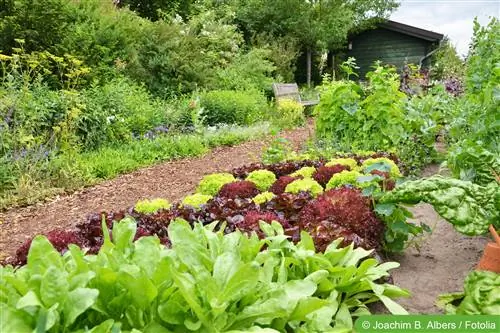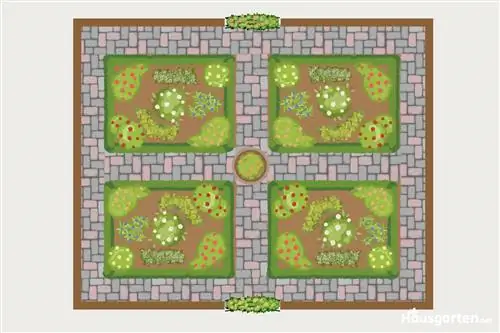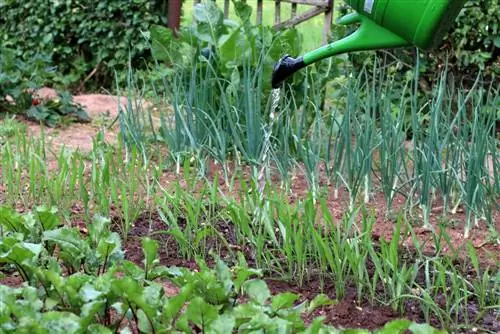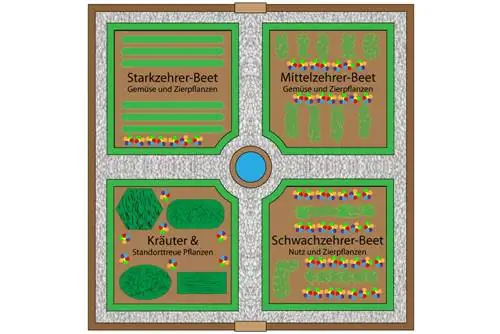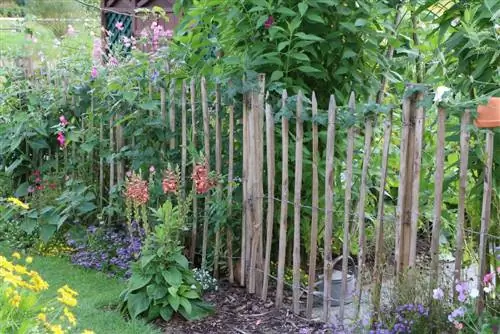- Author admin [email protected].
- Public 2023-12-17 03:39.
- Last modified 2025-06-01 06:48.
If you want to grow your vegetables in your own garden as organically as possible, you should think about a concept in advance of how the project can be realized over many years. If you only plan a very small vegetable patch, you won't have room for the different types of vegetables to be kept changing. The soil also doesn't have time to regenerate regularly. Therefore, in these cases, precise planning is necessary so that large amounts of fertilizer and pesticides do not become necessary after a short period of time.
Site and soil conditions
Salads, vegetables and herbs require a sunny to semi-shady location in the garden. Some species can tolerate the full midday sun, but most prefer a few hours of sun in the morning and late afternoon. On average, about six hours of sunlight per day is optimal.
Soil preparation
Normal garden soil that is well drained and humic is best suited for cultivation. If there is a high sand or clay content, the soil must be prepared accordingly. It is a good idea to analyze the garden soil in the fall of the previous year and improve it if necessary. This means it is optimally prepared for planting in spring.
Tip:
Never apply manure to the garden soil shortly before planting. The ingredients must first be converted into humus and nutrients and the young plants burn when fresh.
Mixed Culture
It's not just location and soil conditions that influence the growth of vegetable plants. The neighborhood conditions also have to be right. There are not only neutral plants that can be easily combined with others, but also those that promote each other's growth or others that hinder one another. That goes together:
- Cauliflower: French beans, peas, celery
- Chinese cabbage: beans, peas, spinach, lettuce
- Strawberries: garlic, lettuce, leeks, radishes, spinach
- Potatoes: French beans, kohlrabi, corn, caraway, horseradish
- Cucumbers: beans, peas, fennel, cabbage, lettuce, beetroot, celery, onions
- Carrots: peas, garlic, chard, radishes, salsify, tomatoes, onions
- Zucchini: basil, runner beans, onions
Planting plan: three-year crop rotation
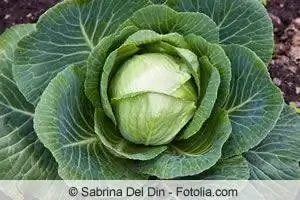
Crop rotation plays a crucial role in the kitchen garden. By adhering to a few important rules, the nutrients in the garden soil can be optimally utilized by the individual plants. Growing the same plant on a bed for years not only leads to the depletion of certain nutrients, but also significantly increases the susceptibility to disease. Therefore, it makes sense to grow plants in a specific order.
- Year: The soil now contains optimal nutrients. The first crops to be used are highly consuming vegetable plants.
- Year: This year it is the turn of medium-intensive plants.
- Year: In the fourth year there are only low nutrient levels in the soil. It is now advantageous to grow low-energy plants.
Before starting again with the heavily consuming plants, it is best to fertilize in autumn or early spring with ripe compost from your own garden. To ensure a varied harvest every year, it is best to divide the area into three individual beds, which are then planted alternately according to the three-year crop rotation.
Planting plan: four-field farming - four-year crop rotation
If you don't just want to plant a small salad bed, but also want to restructure a larger part of the garden as usable space, we recommend four-field farming. A crop rotation model is created here every four years and should always be adhered to. This method is particularly suitable for soils that are not quite as optimal.
- 1. Year: First, green manure is applied. This optimizes the growth conditions for future crops, protects against soil erosion and suppresses weeds. At the same time, it makes sense to create a compost heap if it has not yet been created in the garden.
- 2nd-4th Year: as with three-year crop rotation
While one field lies fallow and can regenerate, heavily consuming vegetables are grown on the second, medium consuming vegetables on the third and low consuming vegetables on the fourth. The switch to less consuming varieties takes place every year.
Classification of vegetables according to nutrient consumption
Salad and vegetables consume different nutrients in different amounts depending on the type.
Heavy eaters
- Eggplant
- Strawberries
- Types of cabbage
- Potatoes
- Carrots
- Beetroot
- Spinach
Middle eaters
- Berry fruit
- Beans and peas
- Fennel
- Cucumbers
- Kohlrabi
- Chard
- Peppers
- Leek
- Radish and radishes
- Tomatoes
- Black Roots
- Onions
Weak eater
- Garden cress
- Herbs
- parsley
- some types of lettuce
Exceptions to crop rotation
There is another factor that makes planning a little more difficult: plants that belong to the same family are not allowed to be grown the following year! This rule particularly applies to the following plant families:
- Cruciferous vegetables (Brassicaceae): all types of cabbage, horseradish, radishes, radishes, mustard, turnips, turnips
- Chenopodiaceae: chard, beetroot, spinach
The plants are plagued by some stubborn pests (such as clubroot). The only justifiable way to prevent an infestation is wide crop rotations. In these cases, crop rotation in four-field farming is preferable to nutrient consumption as a criterion.
Long-term use possible with:
- Strawberries: up to three years, then the plants are replaced with new ones
- Rhubarb: can stay in the same location for many years
- Tomatoes: if no disease occurs, they can be left in the same location for several years
- Asparagus (green asparagus): eight to ten years in one field are problem-free
Suitable pre- and post-crops
Most plants do not use the entire growing season to mature. This is why it is possible to cultivate different types of vegetables one after the other in one field within a year.
- Cauliflower: pre-culture spinach, post-culture lamb's lettuce
- Bush beans: pre-culture lettuce, radishes, post-culture lamb's lettuce or kale
- Cucumbers: pre-culture broad beans, post-culture spinach
- Potatoes: post-culture kale or Brussels sprouts
- Cabbage: pre-culture peas, radishes, spinach
- Carrots: post-culture late bush beans or endives
- Tomatoes: pre-culture spinach, post-culture mustard
- Onions: post-culture endive
Example of a three-year planting
It proves to be advantageous to repeatedly leave areas fallow and convert them into a meadow for beneficial insects for a year. This not only helps the soil regenerate, but also attracts insects that are essential for pollinating fruit trees.
1. Year in the vegetable patch
- Bed 1: Zucchini
- Bed 2: Leeks
- Bed 3: Celery and Tomatoes
- Bed 4: carrots and onions
- Bed 5: Cucumbers for pickling
- Bed 6: Lettuce and peas
- Bed 7: Cauliflower and broccoli
- Bed 8: Kohlrabi and Savoy cabbage
2. Year in the vegetable patch
- Bed 1: radishes and leeks
- Bed 2: cucumbers and dill
- Bed 3: Zucchini
- Bed 4: radishes, peas and radish
- Bed 5: Peas and carrots
- Bed 6: lettuce and carrots
- Bed 7: Strawberries
- Bed 8: Chinese cabbage and endive
3. Year in the vegetable patch
- Bed 1: Lettuce
- Bed 2: Radishes
- Bed 3: Peas
- Bed 4: beneficial insect meadow or green manure
- Bed 5: Celery
- Bed 6: Cucumbers
- Bed 7: Strawberries
- Bed 8: annual herbs
He althy fruit from your own garden
Another part of the kitchen garden is the area where fruit is grown. It should be planted in a location that is as sunny as possible so that the fruits develop sufficient sweetness. When it comes to fruit, a distinction must be made between varieties such as apples, pears and plums, which grow on trees, and the bushes from which, for example, currants or raspberries are harvested. The first fruit can often only be picked from trees after a few years, so long-term planning is necessary. In the case of bushes, however, the first harvest often occurs the year after planting. In order to grow many different types of fruit even in a relatively small garden, there is the columnar fruit with its slender growth, and the espalier fruit, which is grown on a trellis or on the house wall. Both have a relatively small footprint.
Culinary and medicinal herbs
A herb garden should not be missing from any kitchen garden. Herbs such as parsley, chives and Mediterranean herbs such as thyme, rosemary and oregano are grown there. Most herbs are certainly used primarily in the kitchen to refine dishes. In addition, many herbs are also grown for medicinal purposes so that they can be used for tea infusions, baths or compresses when someone is sick. In this regard, chamomile, peppermint and sage are very popular. It is best to create a herb bed close to the kitchen so that you can quickly harvest a few leaves or twigs at any time. Almost all herbs can also be cultivated very well in pots. In this case, the pots can be placed on the terrace or a canopy so that you can still harvest from them even in bad weather. Another variant is the raised bed, where the harvest is also very convenient.
Conclusion
Managing a kitchen garden properly is not that easy. In order to achieve consistently good yields, crop rotation is very important. It is best to divide the available space into individual beds and then grow the vegetables in a strict order on the plots, alternating between them. This ensures that the soil is not leached one-sidedly and that diseases have no chance. After the harvest, green manure can also improve the soil's value again.

